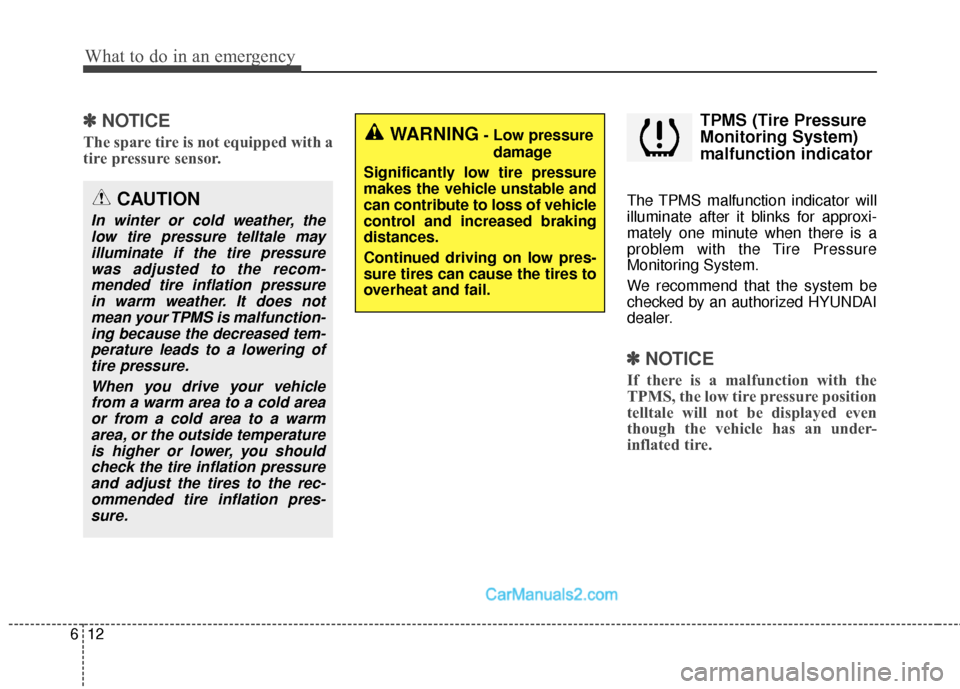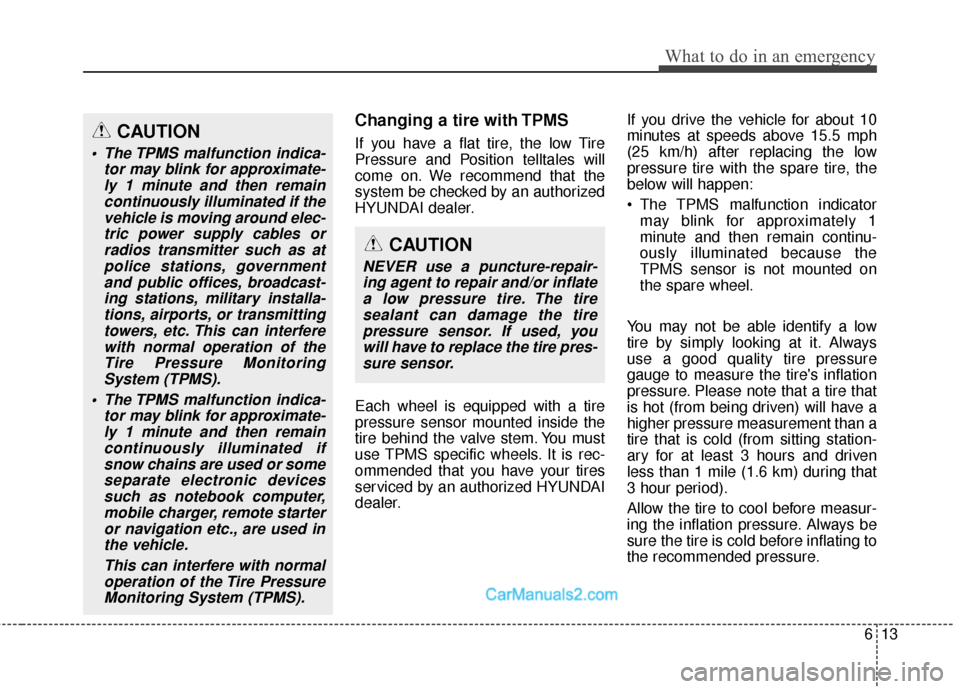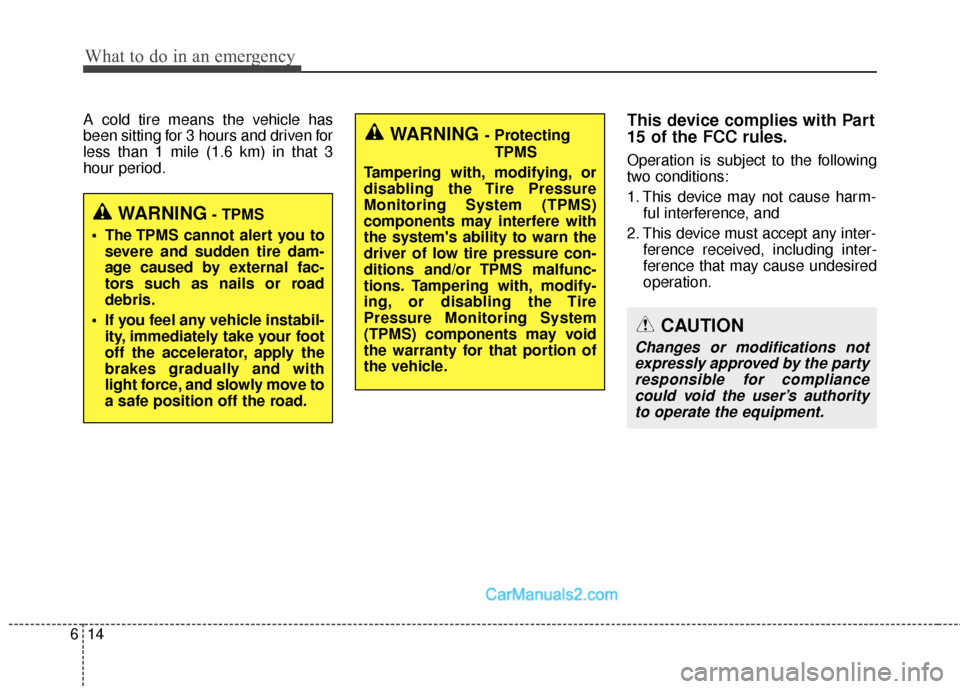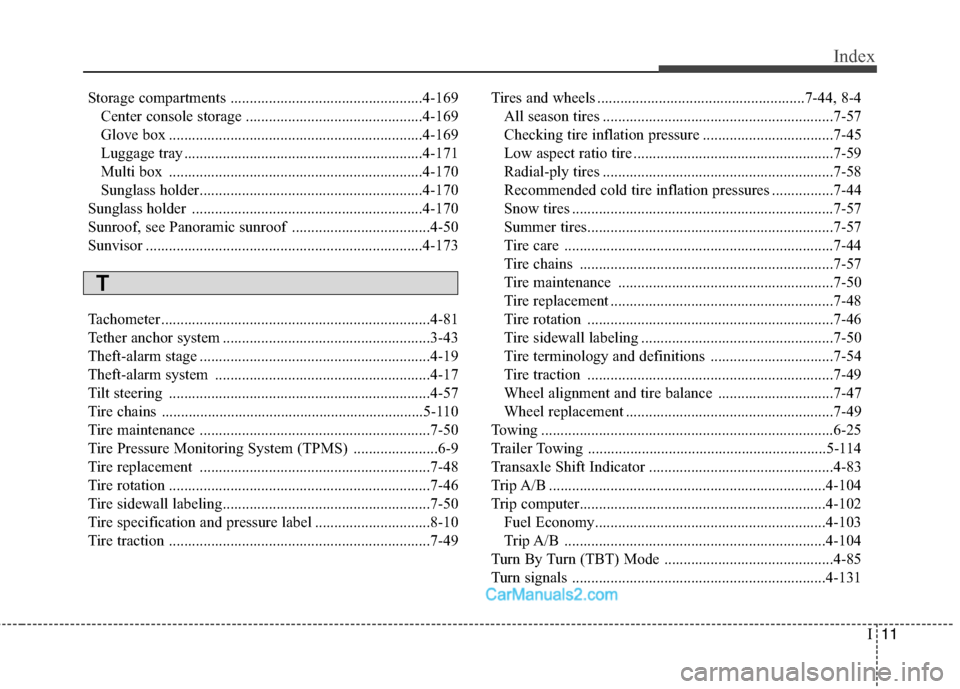2017 Hyundai Santa Fe Sport TPMS
[x] Cancel search: TPMSPage 481 of 614

What to do in an emergency
12
6
✽
✽
NOTICE
The spare tire is not equipped with a
tire pressure sensor.
TPMS (Tire Pressure
Monitoring System)
malfunction indicator
The TPMS malfunction indicator will
illuminate after it blinks for approxi-
mately one minute when there is a
problem with the Tire Pressure
Monitoring System.
We recommend that the system be
checked by an authorized HYUNDAI
dealer.
✽ ✽NOTICE
If there is a malfunction with the
TPMS, the low tire pressure position
telltale will not be displayed even
though the vehicle has an under-
inflated tire.
CAUTION
In winter or cold weather, the
low tire pressure telltale mayilluminate if the tire pressurewas adjusted to the recom-mended tire inflation pressurein warm weather. It does notmean your TPMS is malfunction-ing because the decreased tem-perature leads to a lowering oftire pressure.
When you drive your vehiclefrom a warm area to a cold areaor from a cold area to a warmarea, or the outside temperatureis higher or lower, you shouldcheck the tire inflation pressureand adjust the tires to the rec-ommended tire inflation pres-sure.
WARNING- Low pressure
damage
Significantly low tire pressure
makes the vehicle unstable and
can contribute to loss of vehicle
control and increased braking
distances.
Continued driving on low pres-
sure tires can cause the tires to
overheat and fail.
Page 482 of 614

613
What to do in an emergency
Changing a tire with TPMS
If you have a flat tire, the low Tire
Pressure and Position telltales will
come on. We recommend that the
system be checked by an authorized
HYUNDAI dealer.
Each wheel is equipped with a tire
pressure sensor mounted inside the
tire behind the valve stem. You must
use TPMS specific wheels. It is rec-
ommended that you have your tires
serviced by an authorized HYUNDAI
dealer.If you drive the vehicle for about 10
minutes at speeds above 15.5 mph
(25 km/h) after replacing the low
pressure tire with the spare tire, the
below will happen:
The TPMS malfunction indicator
may blink for approximately 1
minute and then remain continu-
ously illuminated because the
TPMS sensor is not mounted on
the spare wheel.
You may not be able identify a low
tire by simply looking at it. Always
use a good quality tire pressure
gauge to measure the tire's inflation
pressure. Please note that a tire that
is hot (from being driven) will have a
higher pressure measurement than a
tire that is cold (from sitting station-
ary for at least 3 hours and driven
less than 1 mile (1.6 km) during that
3 hour period).
Allow the tire to cool before measur-
ing the inflation pressure. Always be
sure the tire is cold before inflating to
the recommended pressure.CAUTION
The TPMS malfunction indica- tor may blink for approximate-ly 1 minute and then remaincontinuously illuminated if thevehicle is moving around elec-tric power supply cables orradios transmitter such as atpolice stations, governmentand public offices, broadcast-ing stations, military installa-tions, airports, or transmittingtowers, etc. This can interferewith normal operation of theTire Pressure MonitoringSystem (TPMS).
The TPMS malfunction indica- tor may blink for approximate-ly 1 minute and then remaincontinuously illuminated ifsnow chains are used or someseparate electronic devicessuch as notebook computer,mobile charger, remote starteror navigation etc., are used inthe vehicle.
This can interfere with normaloperation of the Tire PressureMonitoring System (TPMS).
CAUTION
NEVER use a puncture-repair-ing agent to repair and/or inflatea low pressure tire. The tiresealant can damage the tirepressure sensor. If used, youwill have to replace the tire pres-sure sensor.
Page 483 of 614

What to do in an emergency
14
6
A cold tire means the vehicle has
been sitting for 3 hours and driven for
less than 1 mile (1.6 km) in that 3
hour period.This device complies with Part
15 of the FCC rules.
Operation is subject to the following
two conditions:
1. This device may not cause harm-
ful interference, and
2. This device must accept any inter- ference received, including inter-
ference that may cause undesired
operation.
WARNING- TPMS
The TPMS cannot alert you to severe and sudden tire dam-
age caused by external fac-
tors such as nails or road
debris.
If you feel any vehicle instabil- ity, immediately take your foot
off the accelerator, apply the
brakes gradually and with
light force, and slowly move to
a safe position off the road.
WARNING - Protecting
TPMS
Tampering with, modifying, or
disabling the Tire Pressure
Monitoring System (TPMS)
components may interfere with
the system's ability to warn the
driver of low tire pressure con-
ditions and/or TPMS malfunc-
tions. Tampering with, modify-
ing, or disabling the Tire
Pressure Monitoring System
(TPMS) components may void
the warranty for that portion of
the vehicle.
CAUTION
Changes or modifications not expressly approved by the partyresponsible for compliancecould void the user’s authorityto operate the equipment.
Page 613 of 614

I11
Index
Storage compartments ..................................................4-169Center console storage ..............................................4-169
Glove box ..................................................................4-169
Luggage tray ..............................................................4-171
Multi box ..................................................................4-170
Sunglass holder..........................................................4-170
Sunglass holder ............................................................4-170
Sunroof, see Panoramic sunroof ....................................4-50
Sunvisor ........................................................................\
4-173
Tachometer ......................................................................4-\
81
Tether anchor system ......................................................3-43
Theft-alarm stage ............................................................4-19
Theft-alarm system ........................................................4-17
Tilt steering ....................................................................4-57\
Tire chains ....................................................................5-110
Tire maintenance ............................................................7-50
Tire Pressure Monitoring System (TPMS) ......................6-9
Tire replacement ............................................................7-48
Tire rotation ....................................................................7-46\
Tire sidewall labeling......................................................7-50
Tire specification and pressure label ..............................8-10
Tire traction ....................................................................7-49\
Tires and wheels ......................................................7-44, 8-4
All season tires ............................................................7-57
Checking tire inflation pressure ..................................7-45
Low aspect ratio tire ....................................................7-59
Radial-ply tires ............................................................7-58
Recommended cold tire inflation pressures ................7-44
Snow tires ....................................................................7-57\
Summer tires................................................................7-57
Tire care ......................................................................7-\
44
Tire chains ..................................................................7-57
Tire maintenance ........................................................7-50
Tire replacement ..........................................................7-48
Tire rotation ................................................................7-46
Tire sidewall labeling ..................................................7-50
Tire terminology and definitions ................................7-54
Tire traction ................................................................7-49
Wheel alignment and tire balance ..............................7-47
Wheel replacement ......................................................7-49
Towing ........................................................................\
....6-25
Trailer Towing ..............................................................5-114
Transaxle Shift Indicator ................................................4-83
Trip A/B ........................................................................\
4-104
Trip computer................................................................4-102 Fuel Economy............................................................4-103
Trip A/B ....................................................................4-10\
4
Turn By Turn (TBT) Mode ............................................4-85
Turn signals ..................................................................4-131
T